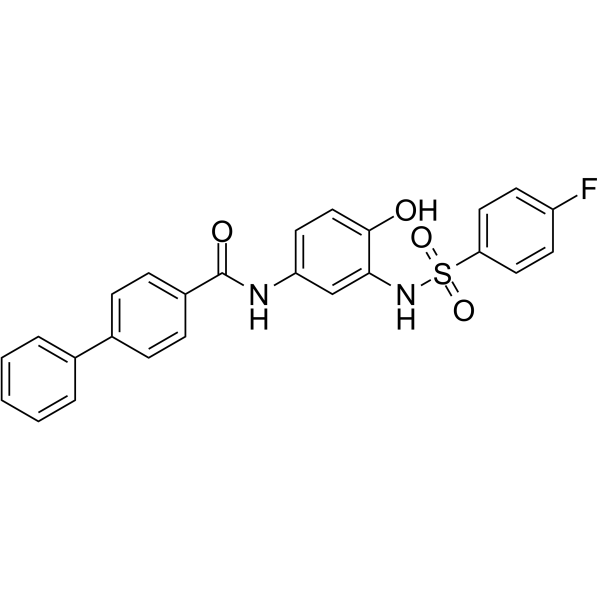| Description |
SN-011 is a potent and selective mouse and human STING inhibitor, with an IC50 of 76 nM for STING signaling. SN-011 competes with cyclic dinucleotide (CDN) for the binding pocket of the STING dimer, blocking CDN binding and STING activation. SN-011 can be used for the research of STING-driven autoimmune and inflammatory disease[1].
|
| Related Catalog |
|
| Target |
IC50: 76 nM (STING signaling)[1]
|
| In Vitro |
SN-011 (1 μM; pretreated for 6 h) significantly suppresses the STING stimulator-induced expression of Ifnb, Cxcl10, and Il6 mRNA in mouse embryonic fibroblasts (MEFs)[1]. SN-011 (0.001-10 μM; pretreated for 6 h) inhibits 2′3′-cGAMP-induced Ifnb expression in MEFs, mouse bone marrow-derived macrophages (BMDMs) and human foreskin fibroblasts (HFFs) with IC50s of 127.5, 107.1, and 502.8 nM, respectively[1]. SN-011 (1 μM; pretreated for 3 h) inhibits 2′3′-cGAMP-induced STING oligomerization and phosphorylation in HFFs[1]. SN-011 (1 μM) suppresses HSV-1 infection (4 h), HT-DNA (1 h), or 2′3′-cGAMP stimulation (30 min) induced STING ER-to-Golgi translocation[1]. Western Blot Analysis[1] Cell Line: Human foreskin fibroblasts Concentration: 1 μM Incubation Time: Pretreated and then stimulated with 2′3′-cGAMP for 1 h Result: Suppressed 2′3′-cGAMP-induced STING oligomerization and phosphorylation.
|
| In Vivo |
SN-011 (5 mg/kg; i.p. 3 times weekly for a month) strongly inhibits hallmarks of inflammation and autoimmunity disease, and protects Trex1−/− mice from death[1]. Animal Model: 4-wk-old Trex1−/− mice[1] Dosage: 5 mg/kg Administration: I.p. 3 times weekly for a month Result: Improved survival of mice. Reduced severe multiorgan inflammation. Reduced serum antinuclear antibody.
|
| References |
[1]. Hong Z, et, al. STING inhibitors target the cyclic dinucleotide binding pocket. Proc Natl Acad Sci U S A. 2021 Jun 15;118(24):e2105465118.
|
